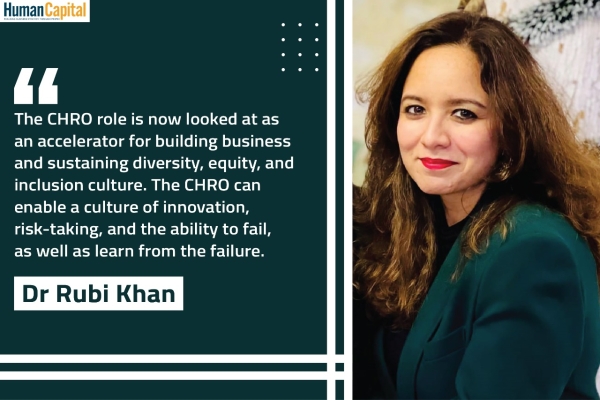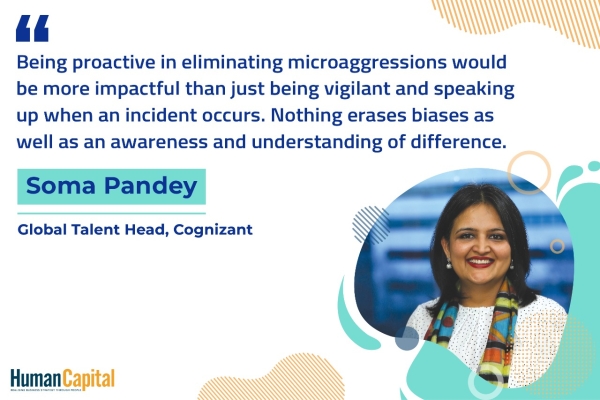In a rapidly changing environment, we need “situational” leaders who are not a result of vacant positions, but of opportunities that ultimately transpire into achievements.
Humanity’s rate of change in the next 20 years is going to be exponential, prompting organisations to also change at a rapid rate by adopting a more cognitive approach towards Talent. With cognitive talent management, organisations focus on predictability, performance and productivity for deriving value for the business (Grewal, 2019).
Research across organisations has indicated that the top 20% accounts for 80% of organisational output and the payoff from the vital few who account for the biggest chunk of organisational output increases as a function of job complexity. Talented employees are “force multipliers”; raising the performance bar for their colleagues, and particularly for their direct reports, shaping high-performing cultures (Premuzic, Adler, Kaiser, 2017). It is imperative to determine what talent already exists in the organisation and which employees have the potential to be effective in larger roles.
Traditionally, Identification of High Potential (HiPo) has involved interventions focussed on individual career success; that fail to measure the ability to engage employees and turn their teams or organisations into high performing machines. The argument is that interventions should focus on simpler, AI-driven, high validity approaches based on fundamental drivers that can predict the key driver to organisational performance (Premuzic, Adler, Kaiser, 2017). Also, there is a difference between identification of HiPo talent and predicting future success, and it is argued that there is a need to look at both Prediction and Assessment.
Assumptions
For the arguments to be meaningful, we would need to make a few upfront assumptions:
1. Difference between performance and potential:
It is necessary to make a distinction between individuals with high performance and individuals with high potential (Silzer & Church, 2010).
2. Potential is a dynamic state, not an end state:
The HiPo is a dynamic personality who will develop beyond her current skills and abilities. While there is disagreement on whether the potential factors themselves viz. learning ability or adaptability, can be developed (Rogers and Smith, 2007), potential skills and abilities may have both natural innate components and components that can be developed.
3. Identifying potential is different from assessing development needs:
We currently use a variety of assessment tools and programmes to assess an individual’s current leadership, skills and to determine the person’s development needs. This assessment is based on a set of competencies (JARL) that try to capture what it takes to be effective in specic roles. This type of assessment measures the individual against end state competencies. However, the individual is dynamic and a work in “developmental progress.” We do not evaluate the person against potential factors such as learning ability and do not identify the person’s potential to grow further and develop
4. Measuring potential for different careers vis-à-vis a specific future role:
The future of cognitive talent explores talent moving in different dimensions or spheres with a personalised career path. Going forward, job related competencies would be focused on performance in specic jobs, while the potential factors would be indicators of a person’s capability to grow into a wide range of career opportunities.
5. Predicting Potential to Develop:
Current skills and abilities are different from potential and need to be considered separately. Accurately assessing a person’ s current knowledge, skills, and abilities is an important rst step, but it should not be confused with determining the person’s ability to grow, adapt, and develop enough to handle more complex future work challenges and responsibilities.
Definition of Potential
Potential refers to the promise or possibility of an individual becoming something more than what he is currently (Silzer & Church, 2010). The underlying denitional question that the organisation seeks to address is, “Potential for what?”
Most commonly, organisations have defined “potential” w.r.t. the ability to move
→ By Role: The potential to move into top or senior management roles
→ By Level: The ability to move two positions or levels above
The “cognitive talent” approach of the future encompasses more diversified movement that entails:
→ By Breadth: The capability to take on broader scope leadership role
→ By Expertise: A consistent track record of exceptional performance
→ By Strategic Position: Key positions that may be at the core of the organisation’s success at that point of time
Potential Assessment Measurement
Given the definition of a HiPo, as someone who is likely to become a key driver of organisational performance, we now need to identify key criteria which define a leader.
In a rapidly changing environment, we need “situational” leaders who are not a result of vacant positions, but of opportunities that ultimately transpire into achievements. The cognitive future demands the deployment of the “outsight principle” that propagates acting like a leader, for thinking like a leader (Ibarra, 2015). The principle requires individuals to start acting like leaders by engaging in a multitude of projects beyond one’s core area, building robust dynamic networks and continuously redefining self.
Taking cue from the “Outsight Principle” and years of scientific research, it is proposed that the following 3 major factors be used for assessing the potential of an employee:
1.) Drive: Defines the will and motivation to work hard and achieve in the job. It can be assessed by standardised tests that measure conscientiousness, motivation and ambition. The past performance track record of an individual is a key factor reflecting his/her drive (This would tackle the predictive challenge).
2.)Ability: Indicates whether the individual is cognitively adept to perform in a job. IQ tests and cognitive ability tests are most often used for assessing individuals on this parameter. IQ or cognitive tests are easily available online these days.
“Ability”, however, goes beyond just intelligence, it encompasses key skills required for a leadership role. Assessment of individual proficiency on required skills, hence becomes a key parameter that can be facilitated through AI-enabled skills matching
3.)Social Networking Skills: In the initial portion of the article, concerns were raised about HiPo identification being centred round individual career success, instead of the ability to take the team along. The networked arena of the future where skills are validated through endorsements (LinkedIn) coupled with the “outsight” principles indicate that a key leadership trait is the ability to connect/network and steer the team towards high performance.
Social skills involve two fundamental abilities: the ability to manage self and the ability to manage others. Emotional intelligence, Social quotient and strength of employee network (internally and externally) are factors that help assess an individual on this parameter. While assessing the strength of an individual’s social skills, the breadth of the network along with its dynamism need to be assessed (Ibarra, 2015)
The model therefore, proposes a combination of tools that can assess these three factors, coupled with predictive modelling using ML for estimating future success as below:
♦ Reliability & Validity: Most of the assessment tools and techniques cited above can be used to reliably and validly assess specic skills, abilities, and characteristics. Structured approaches (BEI, personality instruments, ability tests, and individual psychological assessment) have higher validity and reliability components than less structured approaches (such as unstructured interviews, manager ratings and recommendations, senior manager reviews, and performance reviews, and lend themselves better to predictive modelling.
♦ Prediction: One of the challenges of identifying HiPo individuals is the inherent complexity of making predictions about how successful a person might be in the long-term future. One of the limitations of our existing model is that we do not adjust the denition of high potential as the business strategies and context changes.
It is important to distinguish between accurately assessing specic variables and predictors (data collection) and making predictions about future behaviour and performance (data evaluation). The HiPo identication process needs to effectively do both.
The key steps in this process are:
1. Identify predictor variables: Selecting the best variables to include is the critical rst step that can help or hinder the organisation’s ability to successfully predict future behaviour. Of course, the most predictive variables will probably vary for different organizations, based on the strategic objectives, the desired organisational and individual capabilities, and the organisation’s culture and values.
2. Assess for predictor variables: In general, it is important to consider the reliability, validity, and usefulness of the data that are being used.
3. Predict future behaviour: The step that is currently overlooked in the highpotential identication process is how the data are combined to predict future behaviour. This suggests an opportunity to improve the accuracy of identifying HiPo by using ML powered cognitive methods of combining data into overall predictions.
Questions to be addressed:
♦ What are we actually trying to predict?
♦ What are more effective measures of high potential?
♦ Is potential immutable or something that can be developed?
♦ How does the person’ s motivations and career aspiration affect potential?
♦ Are there different maturity levels of potential?
♦ What is the real impact of communicating high - potential status?
♦ What would be the criterion measure for potential in a predictive empirical study?
♦ How will we know if a person’ s potential ever pays off for the organization?
References:
♦ Grewal, Amber - Mountain View, California | Professional ... (n.d.). Retrieved June 24, 2020, from https://www.linkedin.com/in/ ambergrewal
♦ Ibarra, H. (2015). Act like a leader, think like a leader. Boston, MA: Harvard Business Review Press
♦ Murphy, K. (2008). Explaining the weak relationship between job performance and the rating of job performance. Industrial and Organizational Psychology: Perspectives on Science and Practice, 1 (2), 1 –3 5.
♦ Premuzic, Adler, Kaiser, 2017.What Science Says About Identifying High-Potential Employees. HBR, Oct 2017
♦ Rogers, R. W., & Smith, A. B. (2007). Finding future perfect leaders. Bridgeville, PA: Development Dimensions International.
♦ Silzer, R., Dowell, B. E., Church, A. H., & Waclawski, J. (2010). Strategy driven talent management: A leadership imperative. San Francisco: Jossey Bass.
♦ Ye, Y., Zhu, H., Xu, T., Zhuang, F., Yu, R., & Xiong, H. (2019). Identifying High Potential Talent: A Neural Network Based Dynamic Social Profiling Approach. 2019 IEEE International Conference on Data Mining (ICDM). doi:10.1109/icdm.2019.00082
Do you think hybrid work arrangements would be a common feature of the workplaces going forward?
Trending
-
SBI General Insurance Launches Digital Health Campaign
-
CredR Rolls Out 'Life Happens' Leave For Its Employees
-
Meesho Announces 30-Week Gender-Neutral Parental Leave Policy
-
Microsoft Unveils Tech Resilience Curriculum To Foster An Inclusive Future
-
60% Indian Professionals Looking For Job Change Due To COVID: Survey
-
SpringPeople And Siemens Collaborate For Digital Transformation Push
-
86% Professionals Believe Hybrid Work Is Essential For Work Life Balance: Report
-
Almost 1 In Every 3 People's Personal Life Affected Due To Work Stress
-
Meesho Rolls Out Reset And Recharge Policy For Employees
-
80% Of Talent Leaders & Academics Say Pandemic Changed Skill Needs For Youth: Report
-
Hero Electric Rolls Out 'Hero Care' Program For Employees
-
Human Capital In Collaboration With ASSOCHAM Hosts Virtual Conference
-
IKEA India, Tata STRIVE Collaborate To Create Employability And Entrepreneurship Opportunities
-
SAP India, Microsoft Launch Tech Skilling Program for Young Women
-
DXC Technology, NASSCOM Collaborate For Employability Skills Program
-
Lenskart To Hire Over 2000 Employees Across India By 2022
-
Mindtree Launches Learn-and-Earn Program
-
Tata AIA Extends 'Raksha Ka Teeka' To Its Employees
-
Swadesh Behera Is The New CPO Of Titan
-
NetConnect Global Plans To Recruit 5000 Tech Professionals In India
-
Hubhopper Plans To Hire 60% Of Indian Podcasters By 2022
-
Corporate India Needs More Women In Leadership Roles: Report
-
Aon to Invest $30 Million and Create 10,000 Apprenticeships by 2030
-
Tech Mahindra Launches ‘Gift a Career’ Initiative for Upskilling of Youth
-
40% Women Prefer Flexible Working Options in Post-COVID World: Survey
-
3 out of 4 companies believe they can effectively hire employees virtually: Report
-
Vodafone , CGI and NASSCOM Foundation launch digital skills platform
-
Odisha: Bank, postal employees to deliver cash for elderly, differently-abled persons
-
Skill India launches AI-based digital platform for "Skilled Workforce"
-
Hiring activity declines 6.73% in first quarter: Survey
-
70% startups impacted by COVID-19 pandemic
-
Bajaj Allianz Life ropes in Santanu Banerjee as CHRO
-
Over 70 Percent MSMEs look at cutting jobs to sustain businesses
-
93 Per Cent employees stressed about returning to office post-lockdown
-
Johnson & Johnson India announces family benefits for same gender partners
-
Indian firms turning friendly towards working mothers
-
Welspun India names Rajendra Mehta as new CHRO
-
Wipro partners with NASSCOM to launch Future Skills platform



Human Capital is niche media organisation for HR and Corporate. Our aim is to create an outstanding user experience for all our clients, readers, employers and employees through inspiring, industry-leading content pieces in the form of case studies, analysis, expert reports, authored articles and blogs. We cover topics such as talent acquisition, learning and development, diversity and inclusion, leadership, compensation, recruitment and many more.
Subscribe Now


.JPG)
.JPG)









































Comment